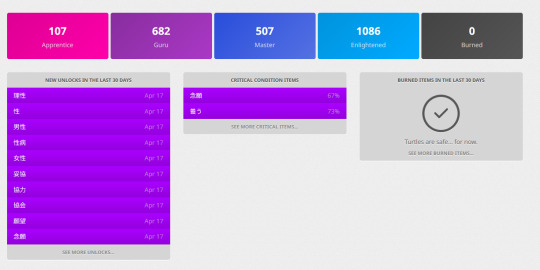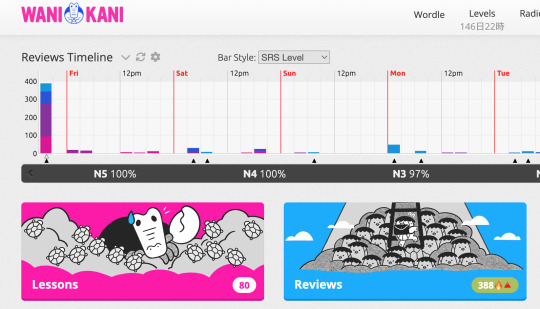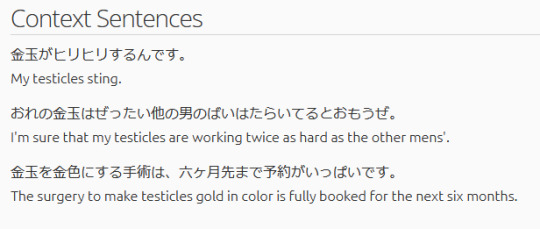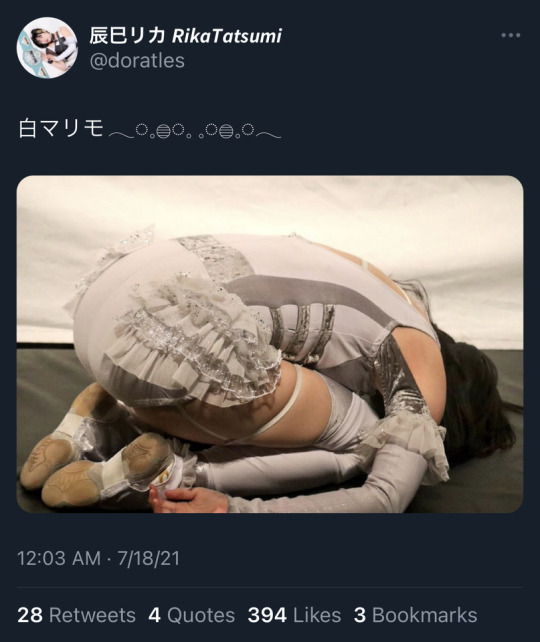#wanikani
Text

Think about gargoyle cock! Got it!
18 notes
·
View notes
Text
Phonetic composition for Wanikani
Remember how I mentioned the book "The Kanji Code" in my lengthy article about on'yomi ("Chinese") readings of kanji?
Turns out the benefits of the book can be had for Wanikani users through the magic of "userscript."

What's the benefit
So, phonetic composition is how a great many of the kanji you're (supposedly) trying to learn are made. These particular kanji are called 形声 or "keisei" - "form-voice" kanji.
For the "form," they contain a part (often referred to as "radical") that gives you the meaning/semantic category of the kanji, like what the concept is mentally filed under.
For the "voice," they contain another part that hints you at how they are pronounced. It is commonly believed that kanji are only pictorials linked to concepts, but for keisei kanji this is not the case. A big part may not pertain to the meaning at all. Spotting the "voice" part can help you recall the on'yomi sounds of kanji much easier and systematically.

Yes, this is specifically for the "Chinese" readings. The Japanese readings are words from a language that had nothing to do with the formation of the original hanzi script, after all.
(Examples are in the original article.)
How it works
Websites are rendered by your browser, but how your browser does this can be extended and changed by scripts that rely on the Javascript language. Nowadays browsers like Chrome or Firefox allow you to install "extensions" that do various jobs for you - blocking ads, returning the ability to copy/paste to pages that block it, etc.
Wanikani, the kanji-learning website, incorporated early on support for so-called userscripts, both a blessing and a curse. Curse because whenever they want to change something on the website, a very vocal userscript culture will complain about breaking their stuff. Blessing because it allows you to extend what WK can do.

How it's done
You can basically follow the guide here, but I must admit I failed to do so because I think something's missing.
What you do is this:
Install Tampermonkey (guide) - this is the basic engine.
Install WK Open Framework (guide) - this is Wanikani's own script support.
Install Keisei support (guide)
Now, if this worked, you should see something like this on various pages - for kanji readings and radicals:

This will tell you if a phonetic component is present in your kanji or if it is itself present in another kanji as a phonetic component. The readings printed in bold are readings still used for that kanji, others listed are merely present in phonetic components but not in the original kanji. Because history.
It also shows you cases where the link is weakened because the pronunciation changed - in the example you see this marked in red. Basically there is a grading system (so far I've seen "heaven", "above", "middle", and "below").
A Caveat
There's only one caveat. Tampermonkey is very powerful. You need to trust the scripts you install, because it could potentially alter what you see on websites or enter/submit stuff for you.
On Chrome there is a good solution for this. When you click on the "Extensions" icon in the top right, you can select "This can read and change site data" from the three dots behind Tampermonkey.
I recommend doing it like this:
Select "On all Sites" during the installing of the WK Open Framework and the "Keisei" support script. (Else the install links have a habit of not working on Chrome.)
Then change it back to "When you click the extension".
Now go back to a tab with Wanikani open. Go back to "Extensions -> This can read and change site data" and select "On wanikani.com".
Congrats! Now Tampermonkey is only enabled on Wanikani by default.
Alternatively, use it in a separate browser. I haven't found an easy way to restrict permissions on Firefox, for example. But if you use it in a separate browser that you only use for Wanikani, you should be good.

Kanpai to the people who made this possible!!
#keisei#phonetic-semantic#learning japanese#wanikani#userscript#WK open framework#Wanikani open framework
9 notes
·
View notes
Text
I’ve decided what I’m going to do with Wanikani mnemonics is use them on a case-by-case basis.
Car wash to remember かわ for river? That’s honestly really good, and has helped me remember.
A (relatively) lengthy story about a missing toe, and a buried car, to remember か for 下? Too much. I need short and sweet.
Like BATTERY HORSE for HORSEPOWER! 🔋🐴
The horse is named リキ.
馬力 ばりき Bariki
Horsepower. 馬 is NOT a kanji they’re trying to teach me yet, but I wanted an example of the りき reading of 力 for Anki, and I already recognize 馬 for horse (うま when it’s an actual horse) from wanting to learn various animal names.
I also like that it teaches me another reading of 馬 in a way that’s easy to remember (BAttery -> ば), meaning I get to look extra smug to no one in particular later when a program finally does want to teach me it.
35 notes
·
View notes
Text
Fellow Japanese learners:
Is WaniKani premium worth it? Or is there a free way to set up spaced repetition learning. Getting to the end of level 3 and not sure what to do going forward...
11 notes
·
View notes
Text

I put over 1000 Japanese vocabs into the enlightened category on wanikani (Level 14) 😭
It's finally time to read JJK 0, I can't push it back anymore, I already learned* Japanese once 🙈
*"""learned"""
2 notes
·
View notes
Text
I haven't gotten my Wanikani reviews down to zero in almost 6 months who else is suffering?
#studying kanji#wanikani#japanese langblr#jlpt#ive been using the site on and off for 4 years and im level 28#currently have 558 reviews#gonna try to get to 0 by the end of this month
3 notes
·
View notes
Text

Background for my Anki
#ankiweb#one peice#japanese vocabulary#n5 vocabulary#japanese n5 vocabulary#japanese vocab list#nihongo#japanese langblr#studyblr#genki#wanikani
3 notes
·
View notes
Text

this year has been very tricky in terms of studying Japanese. working alongside on my first feature documentary film as an editor, getting a Bachelor of Arts and starting my Masters right after that has made it so there's little time and energy left for studying (which I do as a hobby)
I've been stuck on level 38 in Wanikani for a big chunk of the year and I can't dig myself out of the hundreds of reviews. in a way I'm getting the best deal out of my lifetime subscription now lol
that said, tonight I'm trying my best to go down to at least 299. wish me luck!
2 notes
·
View notes
Text
2023年8月16日
today's to-do's are more of a 'guideline' lol. i only have about 30 min for studying as i really need to focus more on my thesis and i also have some chores to do after work, so i'll see how much i actually manage to get done:
wanikani (min. 30 reviews + any new lessons that come up)
finish grammar video from yesterday
irodori -> can-do 1&2 from L3
listen to 2-3 episodes of nihongo con teppei (beginners podcast)
doing wanikani is always such a gamble because i never know if im gonna spend 10 min or 45 min doing 30 reviews. theres no inbetween, either i get all of them right or ive forgotten everything ive ever learned
頑張って��
4 notes
·
View notes
Text
Wanikani: >50
Duolingo/memrise/anki/alphabet drill: - - - -
I'm back! And I suck x)
Thinking about jumping back a couple levels, but also we'll see if this is a blip or I get a rhythm established again
#I also accidentally opened the Tandem app and now have 'wanna talk to [x]' notifs judging me >.>#logged symbols#symbols are talking#langblr#language journal#wanikani
2 notes
·
View notes
Text

I'm ready to go to Japan now.
17 notes
·
View notes
Text
In the Land of Electric Learning Aids Part 3: Bunpro
In the last installment I discussed the well-known kanji study website Wanikani. Have you followed that link? It's funny. It's the About Us page describing what Wanikani is. Guess what? It's out of date.

One would think a website would keep the page where it talks about itself and what it is about up to date...
Anyway, as I mentioned in that article, Wanikani does a good job of teaching you kanji and vocab, but it doesn't teach you grammar. (And it does a comparatively weak job when teaching you words that have a bit of grammar tied to them.)
This is where Bunpro comes in.
Ooh, ahhh, what is it good for?
The main focus of Bunpro is to teach you grammar, but it also teaches vocab, and, to a degree, reading comprehension.
I only found Bunpro because someone on the Wanikani forums slighted it by saying that they think SRS is unneeded for learning grammar. Yes, Bunpro teaches Japanese grammar using the Spaced Repetition method I've talked about before in the previous articles.
The default way is very similar Wanikani - you get a set of grammar items to study, and after you've moved through the set, you are quizzed on them and have to enter an answer.
The beauty of Bunpro is its default way to quiz you, though. It presents you with "mad libs."

Or in other words, a "phrasal template." You merely fill in the missing item(s). Bunpro will also provide you with clues and hints if there are any ambiguities.
Take for example the ko-so-a-do words sore, kore, are, and dore. You will be quizzed with various sentences where you have to fill in your here, there, over there, and where. Hints will tell you how close the respective thing is to the speaker - because kore is close to the speaker, sore is close to the listener, are is apart from either, and dore is to find out where something is.
Part of what's great about this approach - except for some initial frustration - is that it also incorporates more unusual examples and usages - like dore can stand for "let's see" as well.
Ordered but not rigid - Paths and Decks
Where Bunpro definitely is different from Wanikani is its high degree of possible customization. Do you prefer to use the mad libs or would you rather see answers and read them in reviews? Do you want to be quizzed (required to enter text) or do you want to self-evaluate like in Anki? Bunpro lets you choose.
But beyond that, Wanikani presents its content as an ordered dependency tree.

The items you initially unlock in WK will in turn unlock further items. New batches of items are further unlocked only if levels are passed (when you pass your initial reviews on almost all kanji of that level). There's some flexibility there, though. Let's say you don't get a particular kanji to Guru level. Then its vocab words won't unlock, but in general this does not affect the overall progression much - unless you're really stuck in a level with too many missed kanji.
Something like that is called a Path in Bunpro, and Bunpro's default way of teaching grammar is called Lessons. If you follow Bunpro's Lessons you will be taught the grammar lessons in the default order that the site staff thinks is best. But you're also free to use the order of popular textbooks like "Genki". In other words, you can use Bunpro as a supplemental tool for following that course as well.
Please also note that even paths are suggestions only. You can go in any order, nothing is locked from you. So Bunpro allows you to grammar for the final N1 test right from the beginning. Going in default order merely safeguards you from seeing stuff too early that you might not have learned yet. Furthermore you can mark things as mastered that you already learned elsewhere.
Bunpro also teaches vocab through a feature called Decks. This is a beta feature that's also available for grammar. Basically, by default a deck is an unordered bag of items you can draw stuff from to learn, or have a fixed amount drawn for you as your next review batch. What makes this super-cool is that you can order vocab according to how much it is used - in anime, or in general, or on Netflix, etc. So you learn the most useful stuff first - for your own preferred use.
Cram, cram, cram!

One of the most useful features on Bunpro I came across recently is the "Cram" function.
When you learn a new item, you are quizzed on it once, then it goes into your SRS review queue. For some items this is fine, but there are more complex grammar points that warrant more initial practice, like let's say the conjugation of u-verbs, and for that you can create a Cram session.
To do so, you select simply which items you want to practice and how many quiz questions you want on each (or all available!) and then start. So if this was the negation of u-verbs, you would now be asked to put various u-verbs into their casual-negative form or their polite-negative form, with a great variety of verbs to stimulate your brain cells.
I did that specifically for the u-verbs because they contain a little property that requires some practice - they shift sounds from one syllable to another: -mu becomes -manai and -mimasen, -tsu becomes -tanai and -chimasen. Add to this that you have to master this in hiragana, where each means a shift of syllable and an exception for verbs ending in plain -u, and you have something that (IMO) definitely warrants some cramming to drive home.
Furigana and Wanikani
In the article on Wanikani I promised that I'd demonstrate how it is a cool feature that WK exports its information as web service.
Furigana are annotations that show you how to pronounce a given (set of) kanji.

By default, Bunpro shows furigana to help you read. But you can switch them off... or go Wanikani. By registering a Wanikani API key Bunpro can safely access your WK progress and hide furigana for all the words and kanji that you already know. (You can also optionally allow them to be displayed when hovering over.)
This makes a lot of sense when combined with the way Bunpro quizzes grammar. When a kanji word is required, you enter it in hiragana (how it is sounded out) and Bunpro will insert the kanji for you when displaying the answer. (This is close to how kanji typing on a phone works.)
To make this even more cool, you can also import the WK vocab you have learned but not mastered yet into Bunpro for extra practice.
The Pros
Bunpro uses SRS for helping you retain important grammar points.
Mads libs / phrase templates allow you to study grammar in the context of actual sentences.
Example sentences are read by a real Japanese speaker, allowing for immersion and being exposed to actual pitch accent.
Lots of examples, included in the quizzes, making for a great variety of questions.
Furigana help you read kanji, but what you see can be synchronized with your Wanikani learning.
Grammar can be learned in various orders, including that of popular textbooks.
Vocab can be studied in various orders, based on how common it is in various media.
Vocab progress can also be imported from Wanikani.
Cram function allows for additional practice outside the regular SRS cycles.
Highly customizable, including how you review your material.
Unlike Wanikani, Bunpro is organized in a way that helps you study for the JLPT Japanese Language Proficiency Test by level both for grammar and vocab.
There's a section for reading which gives you example text to read for each set of grammar passed. (You can even change the reading direction.)
Like Wanikani, Bunpro uses gamification to help motivate you. As you progress, you earn XP towards gaining levels and various badges.
Each grammar item also contains a section with resources for further reading on the topic, both online as links and offline as references to pages in various books. You can mark those you did peruse as "read."
Bunpro has an undo function for situations where you think you simply made a typo. (If you end abusing it, you're only cheating yourself, though...)
Dictionary definitions and references to grammar and vocab are available as context help when you click on example sentences.
There are forums available to interact with other users.
Bunpro's dashboard is actually quite good and updates itself without reloading the page.

The Cons
Bunpro is clearly a site in active development. While I personally didn't encounter outright bugs, I did find various omissions and other issues - like missing audio and broken links.
This is also true for the Wanikani integration on vocab progress. It marked some words I didn't know as done and a few words I do know were omitted. (On average, it works really well, though. And vocab is still beta.)
There are also content issues with the vocab cards, as they may quiz you on meanings you haven't learned with the card itself - by which I mean, meanings that are not listed at the top of the card. They are in the examples, though. In order to see what I mean, please compare the vocab meanings of "suru" with its example here.
When it comes to the reading section, the amount of material per 15 grammar items wouldn't even fill a page taken together.
Bunpro is a service you pay for. It costs about half as much as Wanikani. And yes, it also offers a lifetime option to pay only once, which also goes on sale around New Year's.
As far as I see, Wanikani progress is not tracked permanently, but you have to sync it manually by pushing a button every once in a while even after registering the API key.
Clicking on words has different results in different places. Clicking on example sentences brings often context help. In Reading sections you get grammar help. In other places it only makes the furigana visible. It's hard to know what to expect when clicking a thing.
Caveats
Well, as you can see with the Cons section, Bunpro is... evolving. This is both good and bad. You can expect more out of Bunpro in the future, and I expect that stuff to be well thought out. But you will also see all these small mistakes that come with that. I personally thought the situation was acceptable, but your mileage may vary.
Conclusion
Instead of a summary, let me share an anecdote of my own experience with Bunpro so far.

So, I was looking at the N5 vocab deck and wondered where to start. I didn't really want to learn more kanji-oriented words... because if I had capacity to spare on that, I would do that to further my current Wanikani progress! So I picked the katakana foreign loan words.
Ignorance is bliss (they say), and so I found myself marking word after word thinking "This isn't so hard!" until I "suddenly" had 100 words in my vocab review queue. Add hubris to ignorance. Yes, katakana words are basically badly pronounced / spelled English words for the most part, but that means you still have to memorize how to spell each of them. (Somehow in my brain I thought this would come naturally, as it all seemed "obvious" at first glance.)
Now I had a review queue with a hundred items and when quizzed on them, I failed most of them. (I personally "blame" part of it on the difference between tsu, zu, su, and their ilk for a lot of them, because which of them is used to emulate an English sound is kind of arbitrary.) And fail I did. How to remedy this?
I wondered if I should kick most of them back out of review, but that seemed, like, well, work.

So I made it into an experiment. Would simply encountering the words over and over in SRS reviews improve the situation by itself even if the amount was huge? (After all, they are kinda familiar.)
How Bunpro quizzes you is that it does a first pass over all items in queue, and then it asks you again for the ones you failed before. Successful items will advance in their SRS level, other items won't. So the items I had the most trouble with came back almost immediately in Reviews, while items with greater rate of success would not, quickly separating the tricky ones from the rest.
Within a few review cycles I had the material internalized. And my vocab study advanced by a hundred words! Ah, the artificial joys of progress bars and percentages! My reward center doesn't care, I still was happy.
Finally, I wrote a lot of positive stuff about Bunpro, and the website does not endorse me in any way. In fact, I pay them. Well, I paid them once. Because, again, I became a big fan in a short time and I do recommend Bunpro wholeheartedly. I'm looking forward to what else the site will provide in the future.
Further installments in this series:
Remembering the Kanji / Anki
Wanikani
2 notes
·
View notes
Text
I don’t like the mnemonics for Wanikani.
I don’t want to say they’re bad. I assume they help a lot of people.
The way my mind works, though, I get tripped up on trying to learn the mnemonics instead of the actual kanji. The English alone in the mnemonics can trip me up.
So what I’ve wound up doing is using Wanikani as a guide for what to study, and a way to test myself, but I’m ignoring their mnemonics and making my own Anki flash cards for kanji in addition to Wanikani.
Which is more effort, but I’ve already gone from getting 50-70% on reviews to 100%, so… It might be safe to conclude this approach works for me.
11 notes
·
View notes
Text
I’m so excited to start learning Japanese again, hopefully I’m not completely illiterate as soon as I return from my months long break
#maybe it’ll make me remember it even better?#as the brain realises that it’s important information?#wishful thinking#text post#Japanese#learning#language#linguistics#wanikani#my beloved#randyposting
2 notes
·
View notes
Text
白 means white
Continuing my habit of learning a new Japanese word and then searching for it in TJPW twitter: I learned 白 in WaniKani level 2 the other day. The On’yomi reading is はく, and I think about Mr. Haku (@misterhakusan) wearing a white Kotatsu Studios hat. The kun'yomi reading is しろ - obviously we think of Rika here. I was hoping to find a lot of "white dragon" stuff on TJPW twitter, but there wasn't much. I was able to turn up this gem:

I got to practice my katakana a little more, even though I don't know what a "marimo" is. A little googling, though, and Rika's joke makes sense!

2 notes
·
View notes
Text
Wanikani Level 1
I’ve finished the first level of WK! I had gotten up to about level 8 a good while ago, but unfortunately fell off the horse. Hopefully this time I’ll become a legendary level 60er ᕙ(⇀‸↼‶)ᕗ
Anyways, I figure it would be cool to keep a log on all the Kanji I’ve learned as I progress through each level. Here is level one.
上 On’: じょう Kn’: うえ Meaning: up/above
下 On’: か Kn’: した Meaning: down/below
大 On’: たい Kn’: おお Meaning: big
工 On’: こう Kn’: Meaning: construction
八 On’: はち Kn’: Meaning: eight
入 On’: にゅう Kn’: Meaning: enter
山 On’: さん Kn’: やま Meaning: mountain
口 On’: こう Kn’: くち Meaning: mouth
九 On’: く Kn’: Meaning: nine
一 On’: いち Kn’: Meaning: one
人 On’: じん・にん Kn’: ひと Meaning: person
力 On’: りょく Kn’: ちから Meaning: power
川 On’: かわ Kn’: Meaning: river
七 On’: しち Kn’: なな Meaning: seven
十 On’: じゅう Kn’: Meaning: ten
三 On’: さん Kn’: Meaning: three
二 On’: に Kn’: Meaning: two
女 On’: じょ Kn’: おんな Meaning: woman
19 notes
·
View notes